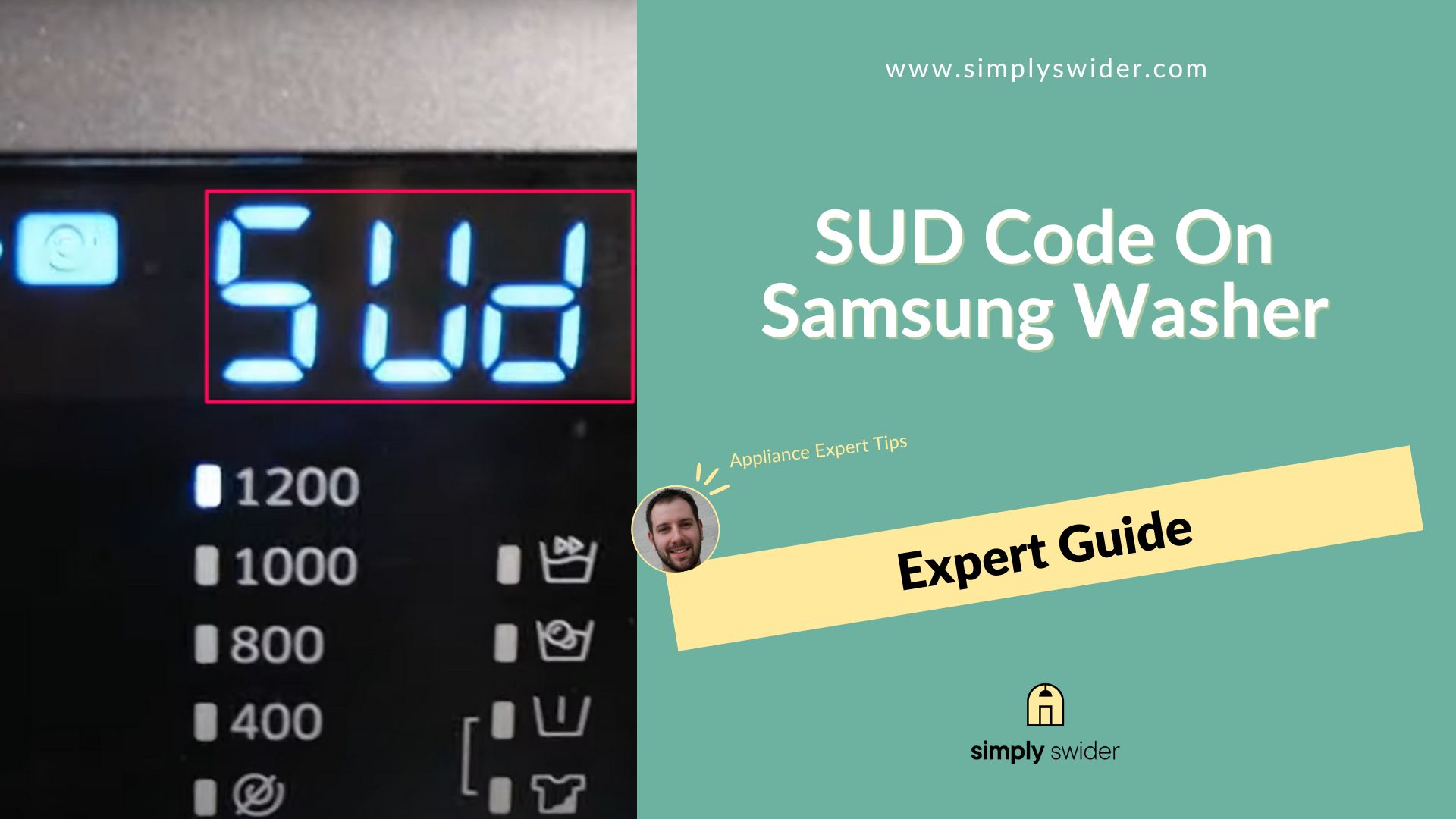A month ago, my phone buzzes. It’s my friend Sara, panicking. “Jason, my Samsung washer just flashed a SUD code and stopped. What do I do?” She’s not the first to ask, and she won’t be the last.
Here’s the deal:
The SUD code on a Samsung washer is more common than you think. I’ve been in the appliance repair game for years, and this one pops up all the time.
But don’t sweat it:
I’ve got you covered. Alongside insights from Ryan Brooks, a top-tier, Columbia-licensed tech, we’re about to deep-dive into the mysteries of the SUD code.
Ready? Let’s get into it.
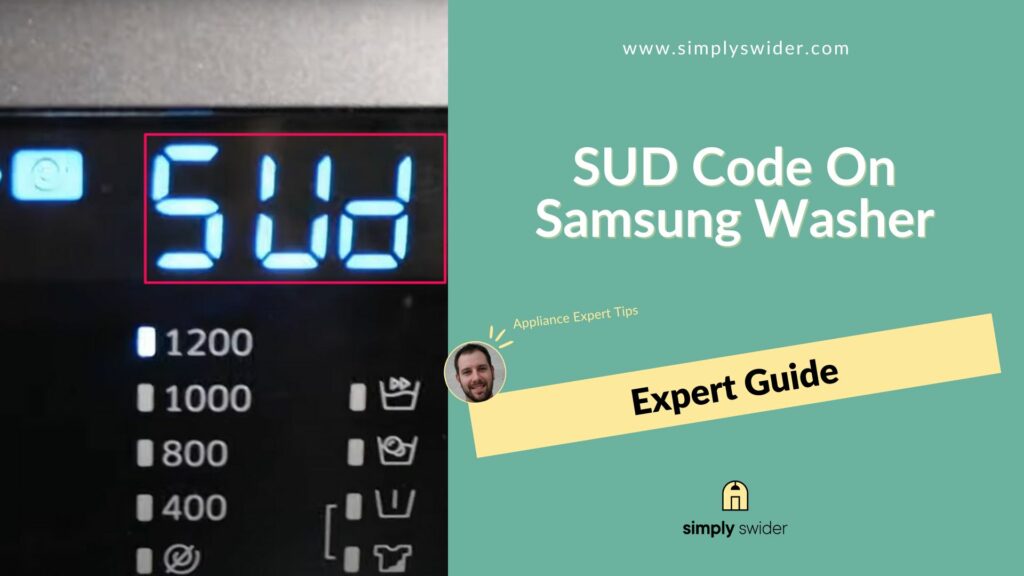
Table of Contents
What Is the SUD Code on Samsung Washers?
According to Samsung, the SUD code on a Samsung washer means there’s too much soap in the washer’s drum. This happens when you use excess or wrong detergent in your washer. It also occurs when there’s a buildup of sud residue and when the drain pump filter is clogged.
Moving forward:
I’ll provide detailed insights on the potential reasons you’ll see the SUD error on your Samsung washer. I’ll also discuss simple troubleshooting steps to rectify each problem.
Stick around to find out more!
4 Common Causes and Troubleshooting Steps for the SUD Error Code
| Commonly Affected Parts | Estimated Cost |
|---|---|
| Drain Pump Filter | $16 – $30 |
1. Excessive Detergent Usage
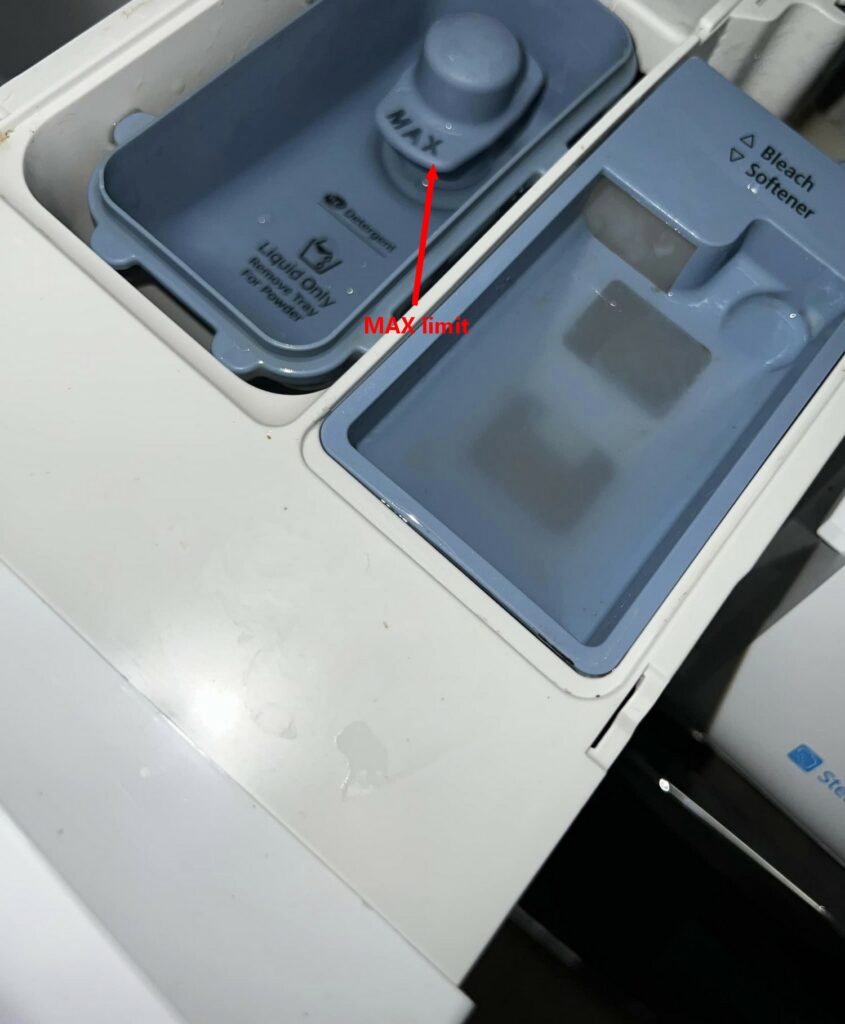
Problem:
The SUD error code indicates the presence of excess soap suds.
As such, the major reason you’d see this code is when you’ve accidentally added too much detergent to your washer.
Typically:
Your washer requires a certain amount of detergent to operate efficiently. Whenever you add more than the expected amount, excess soap suds will form, resulting in the SUD error code.
It’s quite easy to make this mistake—especially when you’re juggling other tasks along with your laundry or don’t know where to put detergent in your washer.
Identification:
Just last week:
A member of our Facebook community experienced this issue and reached out to me for help.
When he told me he’d emptied half a bottle of detergent into his Samsung 6300 Series washer, I knew that was the cause of the problem.
As such:
Before adding detergent to your washer, check the manufacturer’s instructions to know the recommended quantity.
Once you add more than the recommended quantity, excess soap suds will form, leading to the SUD error code.
Solution:
Now:
If you suspect you’ve added too much detergent to your washer, you’d need to wait for about ten minutes for the suds to dissipate.
Make sure to turn off the washer while waiting, as suds can create problems like leaks or motor damage in your machine.
Once the suds reduce or disappear, you can continue the washing cycle.
Alternatively:
I recommend running a long wash cycle at a high temperature in your washer after you’ve removed all the clothes inside the drum. This would help expel the remaining suds present in the washer.
For future purposes, Ryan adds:
“The best way to avoid this problem is by ensuring you add the amount of detergent your washer needs. Luckily, most HE detergents nowadays come with instructions for usage. Be sure to check the manufacturer’s instructions before adding detergent to your washer.”
2. Using the Wrong Detergent
Problem:
Get this:
Another reason your washer would display the SUD code is when you’re using the wrong detergent.
Your Samsung washer is a high-efficiency (HE) washing machine, and it requires low-sudsing HE detergent to function efficiently.
Hence:
When you use the wrong detergent in your washer, an inappropriate amount of suds will be produced. This will result in the dreaded SUD error code.
Identification:
Now:
The only way to know if you’re using the wrong detergent is to examine the body of the detergent. Typically, the low-sudsing detergents should have the words “HE” written on them.
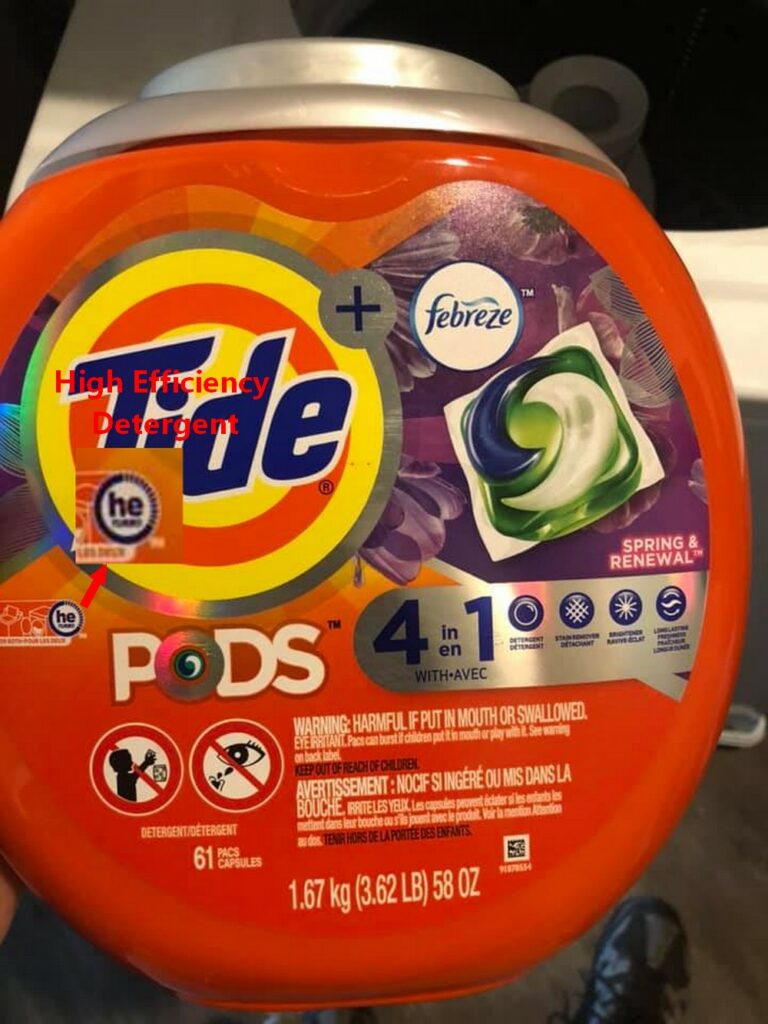
As such:
If the detergent you’re using doesn’t have those words, it should not be used in your high efficiency (HE) washer.
A member of our Facebook community recently experienced this issue. Her Samsung washer abruptly ended its washing cycle and displayed the SUD code error.
Upon further review:
I discovered this happened because she didn’t use a high-efficiency (HE) detergent in her Samsung washer.
As such:
You should always confirm that the detergent you intend to use is an HE detergent before adding it to your washer to avoid oversudsing.
Solution:
But here’s some good news:
If you discover that you added the wrong detergent to your Samsung washer, don’t panic. Simply run additional rinse cycles without adding more detergent.
This will get rid of the excess soap suds in your Samsung washer.
However, Ryan adds:
“For future purposes, always double-check the body of the detergent you use to be sure it’s an HE detergent.”
3. Oversudsing Due to Sud Accumulation

Problem:
In my experience, accumulation of sud residue is a notorious factor that triggers the SUD error code.
You see:
The accumulation of detergent or suds residue within the drum or other parts of the washer can lead to an issue of oversudsing.
Typically:
Sud residue accumulation occurs due to inadequate maintenance or the ongoing use of excessive detergent.
Identification and Solution:
This Reddit user made a post when his Samsung washer model WF45H6300AW/A2 01 started displaying the SUD error code.
In his words:
“Even after cleaning the drain valve at the bottom front and running the self-cleaning cycle multiple times, my Samsung front-load washer still displays SE and SUD error codes every other wash.”
He also added:
“The code seems to happen after washing and during the rinse.”
This was the smoking gun!
You see:
It was evident that his washer showed the SUD error code during the rinse due to lingering sud residue from the wash cycle.
Now:
I’ve dealt with this exact issue on various occasions. And there’s one approach that always does the trick. All you need to do is run a lengthy, high-temperature wash cycle without any laundry in the machine.
To pull this off, follow the steps below:
- Step 1: Initiate an empty wash cycle using the highest water temperature setting. This action will effectively dissolve and eliminate any remaining detergent or suds present in the washer’s drum and other components.
- Step 2: Use a clean cloth to wipe the drum and eliminate any lingering detergent residue.
- Step 3: Allow the washer’s interior to dry by keeping the door open for a few hours.
4. Clogged Drain Pump Filter

| Part | Drain Pump Filter |
| Location | Typically, it can be found behind a small access door at the front of the washer |
| Ease of troubleshooting | Easy |
| Cost | $25 – $35 |
| Repairable | Yes – if it is clogged |
Problem:
Get this:
A clogged drain pump filter can prevent your washer from draining. This leads to oversudsing during the wash cycle. How?
Naturally:
The washer’s inability to drain will prevent soap residues from being flushed away, resulting in high level of suds.
After a while, your washer will display the SUD code error due to the presence of excessive suds.
Identification:
Just last week:
I read a Reddit user’s post about how he’d been battling with the SUD code.
After reading his comments on how the washer’s drain pump filter was clogged with debris, the problem was evident.
I concluded that the washer wasn’t able to drain suds correctly, which caused the SUD error code to appear.
Solution:
Now:
Before cleaning the drain pump filter, unplug your washer and get an empty bowl and a towel.
Once you’ve done this, carry out the following steps:
- Step 1: Find the small access door containing the drain pump filter. This door is commonly situated at the front of your washer for easy access.
- Step 2: To open the access door, press firmly on it.
- Step 3: Position the spout of the emergency drain hose over a container after pulling out the hose.
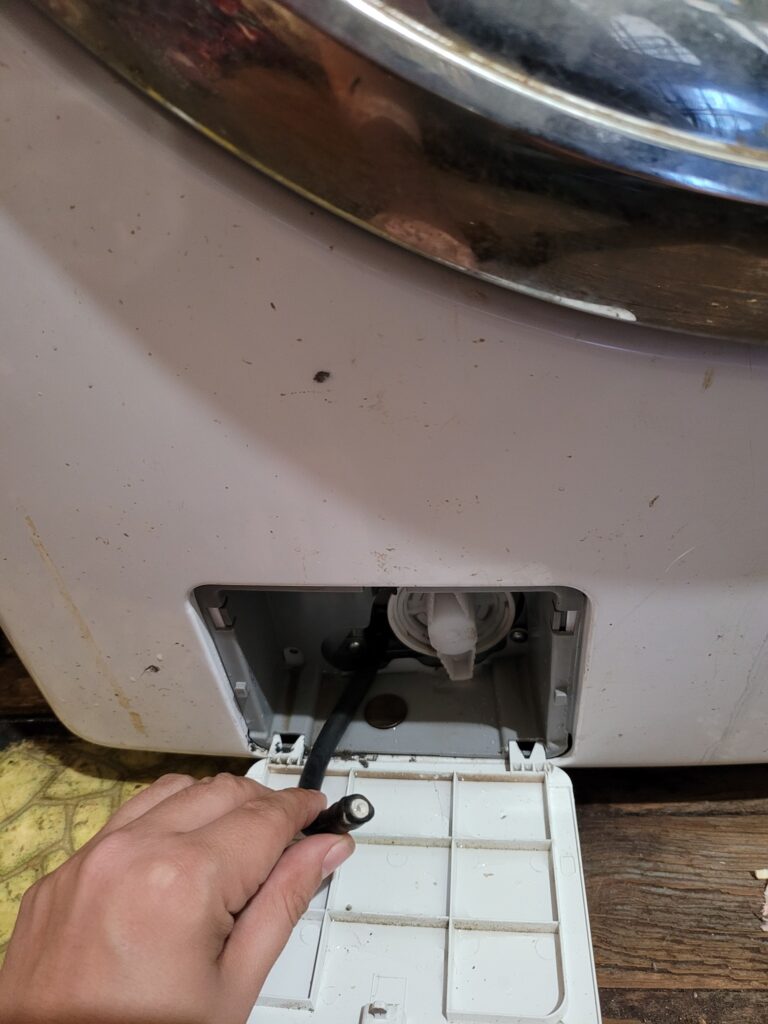
- Step 4: Take off the cap of the drain hose, and empty the water from within into a bowl.
- Step 5: Once the bowl is full, empty the water inside it and continue draining the water from the hose until it stops.
- Step 6: Turn the drain filter counterclockwise to unscrew it.
- Step 7: Remove debris, lint, and detergent residue by cleaning the filter and cabinet.
- Step 8: Put the filter back into the washer and then close it.
- Step 9: Put the cap onto the hose and place it back in the cabinet.
Finally:
Shut the access door and turn on the washer. After cleaning the drain pump filter, it will be much easier for your washing machine to flush out sud residue.
This will resolve the SUD error code that displays on your washer.
Models Most Affected
Based on user reports:
The models below tend to experience the SUD error code more frequently than others.
I’ve also provided some model-specific reasons to explain why the SUD code is a predominant issue for these washers. Here we go!
| Model Number | Model Name | Model-Specific Reason |
|---|---|---|
| WF45H6300AW/A2 01 | Samsung 4.5 Cu. Ft. 13-Cycle High Efficiency Steam Front-Loading Washer | This model’s drain pump filter gets clogged much faster than others. Hence, the sud draining process is slow which results in the SUD error code. |
| WF45T6000A | Samsung 4.5 Cu. Ft. High Efficiency Stackable Front Load Washer | Oversudsing due to sud residue. |
| WF203ANSXAX | Samsung Front Load Washer | The drain pump system on this model is relatively fragile. As such, it easily gets clogged, leading to the SUD error code. |
The Bottom Line
The SUD code on your Samsung washer indicates the presence of excess soap suds or incorrect detergent usage.
Typically:
You’d encounter this error code if you’ve used excessive detergent in your washer. It would also appear when using a non-High-Efficiency (HE) detergent.
Additionally, this error code appears due to the accumulation of sud residue and a clogged drain pump filter.
Thankfully:
You can simply troubleshoot and prevent these issues by:
- Adding detergent to your washer according to the manufacturer’s recommended quantity.
- Using High-Efficiency (HE) detergents.
- Running a high-temperature wash cycle without any laundry in the machine, to clean away any suds residue.
- Cleaning your drain pump filter regularly.
All the same:
If you encounter difficulty following this guide, our “Ask the Expert” feature is available for personalized professional assistance. We’re more than happy to answer any questions you might have.
Finally:
We’d love to know what your experience was like troubleshooting this issue. Please share experience, questions, and suggestions in the comment section below.

